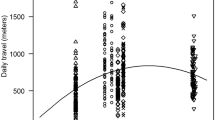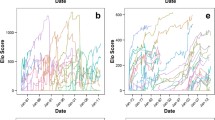Abstract
I analyzed observations from a yearlong study of the positional behavior of Pan troglodytesat the Mahale Mountains National Park to determine whether there are detectable differences in behavior between large and small individuals. Analysis was complicated by a weak correlation between body size and social rank. To factor out rank effects, I performed two types of analyses, depending on the type of data: (1) multiple regressions or (2) comparisons of similarly ranked animals of different body size. With social rank effects accounted for, larger males fed lower in the canopy, fed on the ground more often, fed preferentially among food tree species with smaller adult heights, and climbed significantly less often than smaller males did. Contrary to expectation, large males utilized smaller weight-bearing structures than small males did. These results suggest that large males minimized climbing versus optimizing support diameters, perhaps because vertical climbing is disproportionally expensive for larger animals. The large body weight of chimpanzees compared with other primates suggests that minimizing altitude changes, and therefore vertical climbing, is an important consideration in budgeting daily energy expenditures.
Similar content being viewed by others
References
Altmann, J. (1974). Observational study of behavior: sampling methods.Behavior 49: 227–267.
Cant, J. G. H. (1987). Effects of sexual dimorphism in body size of feeding postural behavior of Sumatran orangutans (Pongo pygmaeus).Am. J. Phys. Anthropol. 74: 143–148.
Cant, J. G. H. (1992). Positional behavior and body size of arboreal primates: A theoretical framework for field studies and an illustration of its application.Am. J. Phys. Anthropol 88: 273–284.
Cartmill, M. (1972). Arboreal adaptations and the origin of the order primates. In Tuttle, R. (ed.),The Functional and Evolutionary Biology of Primates, Aldine, Chicago, pp. 97–122.
Cartmill, M. (1974). Pads and claws in arboreal locomotion. In Jenkins, F. A., Jr. (ed.),Primale Locomotion, Academic Press, New York, pp. 45–83.
Cartmill, M., and Milton, K. (1977). The lorisiform wrist joint and the evolution of “brachiating” adaptations in the Hominoidea.Am. J. Phys. Anthropol. 47: 249–272.
Chivers, D. J. (1973). An introduction to the socioecology of Malayan forest primates. In Michael, R. P., and Crook, J. H. (eds.),Comparative Ecology and Behaviour of Primates, Academic Press, New York, pp. 101–146.
Doran, D. M. (1993). Sex differences in adult chimpanzee positional behavior: The influence of body size on locomotion and posture.Am. J. Phys. Anthropol. 91: 99–115.
Crompton, R. H. (1984). Foraging, habitat structure and locomotion in two species ofGalago. In Rodman, P. S., and Cant, J. G. H. (eds.),Adaptations for Foraging in Nonhuman Primates, Columbia University Press, New York, pp. 73–111.
Dunbar, R. I. M., and Dunbar, E. P. (1974). Ecological relations and niche separations between sympatric terrestrial primates in Ethiopia.Folia Primatol. 21: 36–60.
Fleagle, J. G., and Mittermeier, R. A. (1980). Locomotor behavior, body size and comparative ecology of seven Surinam monkeys.Am. J. Phys. Anthropol. 52: 301–314.
Gautier-Hion, A. (1978). Food niches and coexistence in sympatric primates in Gabon. In Chivers, D. J., and Herbert, J. (eds.),Recent Advances in Primatology, Vol. 1, Academic Press, New York.
Grand, T. I. (1972). A mechanical interpretation of terminal branch feeding.J. Mammal 53: 198–201.
Grand, T. I. (1984). Motion economy within the canopy: Four strategies for mobility. In Rodman, P. S., and Cant, J. G. H. (eds.),Adaptations for Foraging in Nonhuman Primates, Columbia University Press, New York, pp. 54–72.
Hiadik, C. M. (1979). Diet and ecology of prosimians. In Doyle, G. A., and Martin, R. D. (eds.),The Study of Prosimian Behavior, Academic Press, New York.
Hiadik, C. M., and Hiadik, A. (1972). Disponibilites alimentaires et domaines vitaux des primates a Ceylan.Terre Vie 26: 149–215.
Hunt, K. D. (1989).Positional Behavior in Pan troglodytesat the Mahale Mountains and Gombe Stream National Parks, Tanzania, Ph.D. dissertation, University of Michigan, University Microfilms, Ann Arbor.
Hunt, K. D. (1991). Positional behavior in the Hominoidea.Int. J. Primatol. 12: 95–118.
Hunt, K. D. (1992a). Social rank and body weight as determinants of positional behavior inPan troglodytes.Primates 33: 347–357.
Hunt, K. D. (1992b). Sex differences in chimpanzee positional behavior, activity budget and diet.Bull. Chicago Acad. Sci. 15(1): 4.
Hunt, K. D. (1992c). Positional behavior ofPan troglodytes in the Mahale Mountains and Gombe Stream National Parks, Tanzania.Am. J. Phys. Anthropol. 87(1): 83–107.
Janson, C. (1985). Aggressive competition and individual food consumption in wild brown capuchin monkeys (Cebus apella).Behav. Ecol. Sociobiol 18: 125–138.
Jungers, W. L. (1984). Scaling of the hominoid locomotor skeleton with special references to lesser Apes. In Preuschoft, H., Olivers, D. J., Brockelman, W. Y., and Creel, N. (eds.),The Lesser Apes: Evolutionary and Behavioral Biology, Edinburgh University Press, Edinburgh, pp. 146–169.
Jungers, W. L. (1985). Body size and scaling of limb proportions in primates. In Jungers, W. L. (ed.),Size and Scaling in Primate Biology, Plenum, New York, pp. 337–343.
Jungers, W. L., and Susman, R. L. (1984). Body size and skeletal allometry in African apes. In Susman, R. L. (ed.),The Pygmy Chimpanzee, Plenum, New York, pp. 131–178.
Mittermeier, R. A., and van Roosmalen, M. G. (1981). Preliminary observations on habitat utilization and diet in eight Surinam monkeys.Folia Primatol. 36: 1–39.
Moreno-Black, G., and Maples, W. R. (1977). Differential habitat utilization of four cercopithecidae in a Kenyan forest.Folia Primatol. 27: 85–107.
Nishida, T. (1968). The social group of wild chimpanzees of the Mahale Mountains.Primates 9: 167–224.
Rodman, P. S. (1978). Diets, densities, and distributions of Bornean primates. In Montgomery, G. (ed.),The Ecology of Arboreal Folivores, Smithsonian Institution Press, Washington, DC., pp. 465–478.
Rollinson, J. (1975).Interspecific Comparisons of Locomotor Behavior and Prehension in Eight Species of African Forest Monkey—A Functional and Evolutionary Study, Ph.D. thesis, University of London, London.
Rollinson, J., and Martin, R. D. (1981). Comparative aspects of primate locomotion, with special references to arboreal cercopithecines. In Day, M. H. (ed.),Vertebrate Locomotion, Academic Press, New York, pp. 377–423.
Rudran, R. (1978a). Intergroup dietary comparisons and folivorous tendencies of two groups of blue monkeys (Cercopithecus mitis stuhlmanni). In Montgomery, G. G. (ed.),The Ecology of Arboreal Folivores, Smithsonian Institution Press, Washington, DC., pp. 483–503.
Rudran, R. (1978b). Socioecology of the blue monkeys (Cercopithecus mitis stuhlmanni) of the Kibale Forest, Uganda. Smithsonian Contributions to Zoology, No. 249, Smithsonian Institute Press, Washington, DC.
Shea, B. T. (1984). An allometric perspective on the morphological and evolutionary relationships between pygmy (Pan paniscus) and common (Pan troglodytes) chimpanzees. In Susman, R. L. (ed.),The Pygmy Chimpanzee, Plenum, New York, pp. 89–130.
Struhsaker, T. T. (1978). Food habits of five monkey species in the Kibale Forest, Uganda. In Chivers, D. J., and Herbert, J. (eds.),Recent Advances in Primatology, Vol. 1, Academic Press, New York.
Sussman, R. W. (1974). Ecological distinctions of sympatric species of Lemur. In Martin, R. D., Doyle, G. A., and Walker, A. C. (eds.),Prosimian Biology, Duckworth, London.
Taylor, C. R., Caldwell, S. L., and Rowntree, V. J. (1972). Running up and down hills: some consequences of size.Science 178: 1096–1097.
Terborgh, J. (1983).Five New World Primates: A Study in Comparative Ecology, Princeton University Press, Princeton, NJ.
Uehara, S., and Nishida, T. (1987). Body weights of wild chimpanzees (Pan troglodytes schweinfurthii) of the Mahale Mountains National Park, Tanzania.Am J. Phys. Anthropol 72: 315–322.
Author information
Authors and Affiliations
Rights and permissions
About this article
Cite this article
Hunt, K.D. Body size effects on vertical climbing among chimpanzees. Int J Primatol 15, 855–865 (1994). https://doi.org/10.1007/BF02736072
Received:
Revised:
Accepted:
Published:
Issue Date:
DOI: https://doi.org/10.1007/BF02736072




